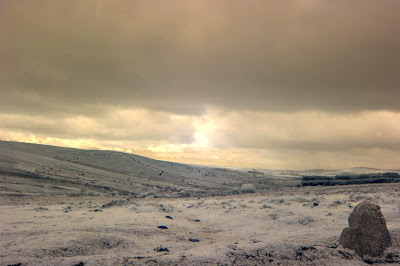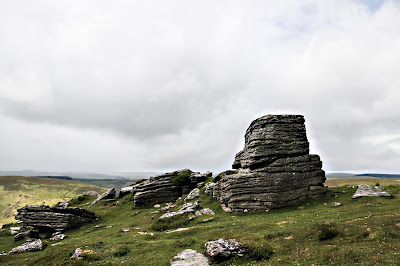It was going to be a hot day so what better way to spend it than walking along the coast? This time we were filling in a gap between Pentireglaze, just outside of Polzeath, and Port Quin. After we've finished this bit, we've only got about 30 miles of the Cornish Coastal Footpath to do to complete our challenge.
 |
| The route was out and back along the coastal footpath. Navigation was easy - keep the sea to our left on the way out and to our right on our way back. At around 4.6miles, and over moderately challenging terrain, it was far enough under the hot conditions. |
 |
| The satellite view of our route. |
 |
| A thistle of some sort. I really should make sure that I get leaves and a side shot of flowers so that I'm better able to identify them. But, whatever it is, it adds a splash of colour to the sides of the footpath. |
 |
| Unfortunately we missed the coastal flowers at their prime but the remnants, such as these seed heads of Thrift, are still photogenic. |
 |
| Looking westwards towards Rumps Point with the small island, the Moule, lying just off shore. Rumps Point is, in fact, a twin headland, enjoined with Pentire Point, which would be to the left. Continue around and you'll get to New Polzeath and Polzeath. Both feature prominently in the world of surfing. |
 |
| Two people painting the coastline. Looking at what they've done so far, I'm not sure they are seeing what I'm seeing when I look from this point. But it's probably too early to judge. The finished products might be absolutely amazing. I did offer to pose for them in a Poldarkesque fashion but they weren't impressed. |
 |
| An interesting rock formation we came across called Lundy Hole. It's actually a collapsed sea cave. Legend has it that, as St Menfre was combing her hair, the Devil appeared in front of her. She threw her comb at him with such force that in his haste to get back to hell he dug Lundy Hole. And who was St. Menfre? According to the Cornish lists,Menfre, alias Menefreda, was one of the many holy daughters of King Brychan Brycheiniog (we've come across his progeny at other churches around us). She appears to have been active in Wales,around Minwear, near Haverfordwest, in Dyfed but, later, left her native land in order to evangelise the Cornish.She settled at Tredresick and then the place now called St. Minver, near Padstow, and apparently lived an austere life there in her little cell. |
 |
| Guess who has got a new rucksack? |
 |
| One of the pleasures of walking the coastal footpath is coming across little coves that are quite isolated and rarely visited by anyone. Of course, the reason for this might be that they are inaccessible because of the steep cliffs. |
 |
| Now here's an odd thing: my dislike of cold water is well known but, when I see the sea as inviting as this, I'm almost tempted to take a dip. To be honest, that's not quite true but I did ponder on the possibility of carrying a half-suit on the off-chance that the mood takes me again. |
 |
| Kellan Head in the distance with Doyden Point in the mid-ground and that's where we were heading. |
 |
| In 1827 the headland at Doyden was bought by a wealthy Wadebridge bon-viveur called Samuel Symons. He built this truncated Gothic tower, gradiosley known as Doyden Castle, as a place to entertain his friends, where they spent their time drinking and gambling. You may recognise it as the place where Mrs Tishall held Doc Martin's offspring hostage in an episode of the eponymous TV series. It was also used in Poldark, Nowadays it's used as a holiday cottage by the National Trust. Whilst on the subject of Doc Martin, I do believe we had previously passed the actor who plays PC Penhale out for a walk on the coast with a lady companion. As they are filming the next series in Port Isaac at the moment, it's not impossible - either that or John Marquez has a doppelganger. |
 |
| And here it is in infra-red. |
 |
There were two mines at Port Quin and near Doyden Point, there are the mineshafts of Gilson's Cove Mine either side of the coastal path. This was a mixed lead/silver and antimony mine from which a little copper ore was also extracted. This shaft goes down to sea level, the other, close by, deeper. Keen eyes at this point will spot the remains of the platform for a horse-powered winding device, known as a whim, which was used to haul ore up from the mine. Look out for the flat, circular area where the horse would have travelled, tethered to the winding gear.
|
 |
| I haven't come across a gate of this style before and couldn't figure out why there were three removable lateral pieces. These didn't seem to add anything in terms of access or barrier over and above the gate to the right. I'm open to suggestions - sensible or otherwise. |
 |
| Most of the dry stone walls we passed were bedecked with the spikes of Navelwort or Pennywort (Umbilicus rupestris). I think I've mentioned many times before that a local name for this is Pig's Bum, becuase the indentation in the middle of the leaves looks, to some. more like a pig's bum than a navel. I'm neutral on this matter. |
 |
| It's that new rucksack again, this time going downhill. |
 |
| A Cornish traffic jam. If it's not tractors, it's pheasants. |
 |
| And then it was back to feed our Oxford Sandy and Black pigs. Nice healthy looking animals but much more feisty than our previous breed. |

































































